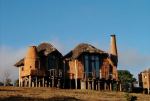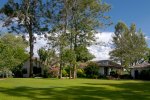 The Ngorongoro Crater in northern Tanzania is understandably regarded as the eight Natural Wonder of the World and quite rightly so. This unique World Heritage Site is the largest intact caldera in the world and with its walls standing proudly at over 2,000 feet it is estimated that its original height would have overshadowed Mount Kilimanjaro.
The Ngorongoro Crater in northern Tanzania is understandably regarded as the eight Natural Wonder of the World and quite rightly so. This unique World Heritage Site is the largest intact caldera in the world and with its walls standing proudly at over 2,000 feet it is estimated that its original height would have overshadowed Mount Kilimanjaro.
The floor of the crater covers an area in excess of 100 square miles and provides a sheltered haven for nearly 25,000 animals including all of the Big Five (elephant, buffalo, rhino, lion and leopard). Aside from wildebeest and zebra which migrate away from the crater during the wet season, all of the resident wildlife are more than happy to stay put throughout the year. The only animal notably absent from the Ngorongoro Crater is the giraffe which apparently find the walls too steep to negotiate.
Perhaps one of the most interesting aspects of the Ngorongoro Crater is the fact that man and beast have survived alongside one another here for centuries. The local Maasai often graze their cattle on the fertile crater floor with barely a flicker of the tail from the perilously high concentration of lion which inhabit the open plains.
The Ngorongoro Crater has dramatically increased in popularity over the last two decades and it can be quite a busy place with high numbers of safari vehicles during peak season. Our advice is – don’t be put off as this is a “must see” on any northern Tanzania itinerary and with a good choice of comfortable accommodation in the area, combines perfectly with Tarangire, Lake Manyara and the Serengeti.
Some of our clients’ favourites properties in the Ngorongoro Highlands:
Crater Lodge is undoubtedly the most opulent accommodation in the area and is perched right on the rim of the crater within the Ngorongoro Conservation Area. The design of the lodge was inspired by the traditional Maasai manyattas and each of the thirty luxurious suites has with spectacular views down into the crater.
Plantation Lodge is located amongst the coffee plantations in the lush green hills around Karatu just outside the Ngorongoro Conservation Area. With sixteen individually styled suites, good food and a warm welcome, this is one of the best small lodges in the area.
Gibbs Farm is a characterful working farm located on the slopes of the Ngorongoro Conservation Area, mid-way between Lake Manyara and the crater. There are twenty cosy cottages all of which have recently been upgraded to even higher standards than before. One of the features of Gibbs Farm is its “Farm Life” program where guests are given an insight into the interesting history and culture of a working coffee farm.
- Crater Lodge
- Gibbs Farm
- Plantation Lodge


